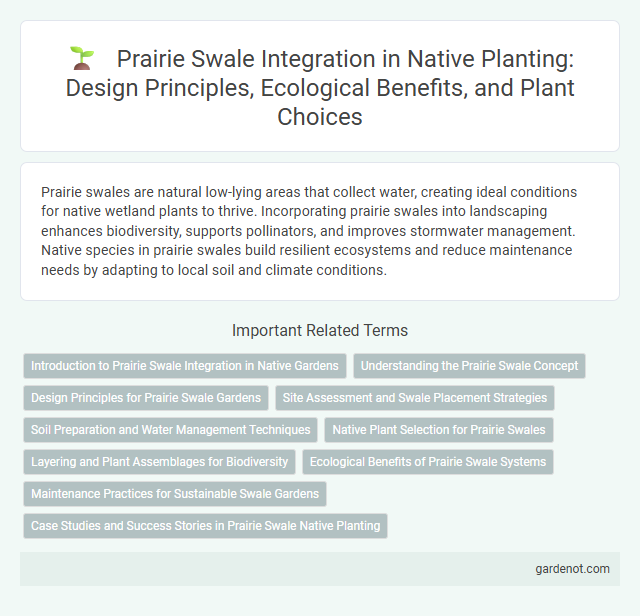Prairie swales are natural low-lying areas that collect water, creating ideal conditions for native wetland plants to thrive. Incorporating prairie swales into landscaping enhances biodiversity, supports pollinators, and improves stormwater management. Native species in prairie swales build resilient ecosystems and reduce maintenance needs by adapting to local soil and climate conditions.
Introduction to Prairie Swale Integration in Native Gardens
Prairie swales are shallow, natural depressions designed to manage stormwater while supporting native plant biodiversity. Integrating prairie swales in native gardens enhances water filtration, reduces soil erosion, and creates habitats for pollinators and native fauna. Strategic planting with grasses like little bluestem and wildflowers such as coneflowers optimizes ecological benefits and garden resilience.
Understanding the Prairie Swale Concept
Prairie swales are low-lying landscape features that collect and slowly release stormwater, supporting native wetland and prairie plant species adapted to fluctuating moisture levels. These natural depressions enhance biodiversity by creating microhabitats for diverse flora and fauna, while improving water quality through sediment filtration and groundwater recharge. Implementing prairie swales in ecological restoration projects promotes sustainable water management and habitat connectivity within native prairie ecosystems.
Design Principles for Prairie Swale Gardens
Prairie swale gardens incorporate native plants that thrive in intermittent wet conditions, enhancing biodiversity and water management. Design principles emphasize selecting deep-rooted grasses and wildflowers to promote soil stabilization and filtration while supporting pollinators. Implementing contour grading and swale placement maximizes natural water retention, reduces runoff, and creates resilient habitats.
Site Assessment and Swale Placement Strategies
Site assessment for prairie swale installation involves evaluating soil permeability, hydrology, and existing vegetation to ensure optimal water retention and native plant health. Strategic swale placement prioritizes areas with natural water flow paths, gentle slopes, and lower elevations to maximize rainwater infiltration and reduce erosion. Understanding site-specific conditions supports effective prairie restoration by promoting biodiversity and improving stormwater management.
Soil Preparation and Water Management Techniques
Prairie swale soil preparation involves deep loosening and the removal of invasive species to enhance root penetration and nutrient uptake. Water management techniques include creating gentle depressions to collect and retain runoff, promoting natural infiltration and reducing erosion. Incorporating organic mulch layers helps maintain soil moisture and supports microbial activity essential for plant health.
Native Plant Selection for Prairie Swales
Selecting native plants for prairie swales ensures erosion control, water filtration, and habitat creation by leveraging deep-rooted grasses like big bluestem (Andropogon gerardii) and switchgrass (Panicum virgatum). Incorporating native sedges such as Pennsylvania sedge (Carex pensylvanica) and wildflowers like black-eyed Susan (Rudbeckia hirta) enhances biodiversity and supports pollinators. Proper plant selection optimizes soil permeability and resilience against heavy rainfall, maintaining the ecological balance of prairie swales.
Layering and Plant Assemblages for Biodiversity
Prairie swales utilize strategic layering of herbaceous plants, grasses, and sedges to create diverse vertical strata that support a wide range of pollinators and soil microbes. Plant assemblages in these wetlands include native species such as switchgrass (Panicum virgatum), big bluestem (Andropogon gerardii), and blueflag iris (Iris virginica), which promote ecological resilience and water filtration. This complex layering fosters microhabitats essential for amphibians, insects, and migratory birds, enhancing overall prairie ecosystem biodiversity.
Ecological Benefits of Prairie Swale Systems
Prairie swale systems enhance biodiversity by providing essential habitat and food resources for native pollinators, birds, and small mammals. These systems improve water quality through natural filtration and reduce stormwater runoff by increasing soil infiltration and groundwater recharge. Their deep-rooted native plants stabilize soil, prevent erosion, and sequester carbon, contributing to ecosystem resilience and climate change mitigation.
Maintenance Practices for Sustainable Swale Gardens
Prairie swale maintenance requires regular monitoring of native vegetation to prevent invasive species from overtaking the area, ensuring biodiversity and ecosystem health. Controlled burns or selective mowing promote growth of deep-rooted prairie plants, enhancing soil infiltration and reducing erosion. Periodic removal of accumulated debris and adaptive watering during drought conditions support sustainable swale garden performance and resilience.
Case Studies and Success Stories in Prairie Swale Native Planting
Prairie swale native planting projects have demonstrated significant improvements in biodiversity, with case studies reporting increased populations of pollinators such as monarch butterflies and native bees. Successful restoration efforts in Midwestern U.S. prairies show enhanced water filtration and reduced soil erosion through the reintroduction of native grasses like little bluestem and switchgrass. Data from these initiatives highlight increased carbon sequestration, contributing to local climate resilience and ecosystem health.
Prairie swale Infographic

 gardenot.com
gardenot.com